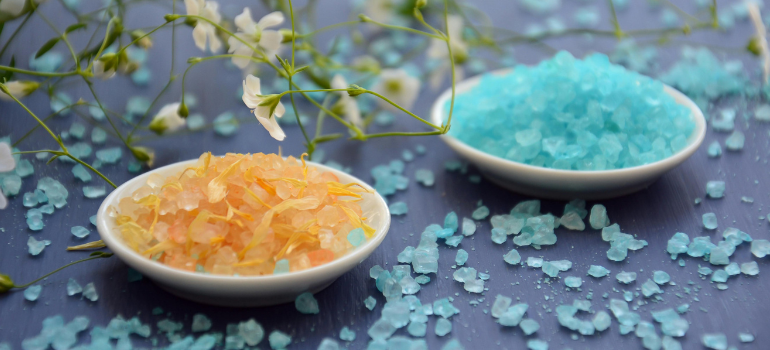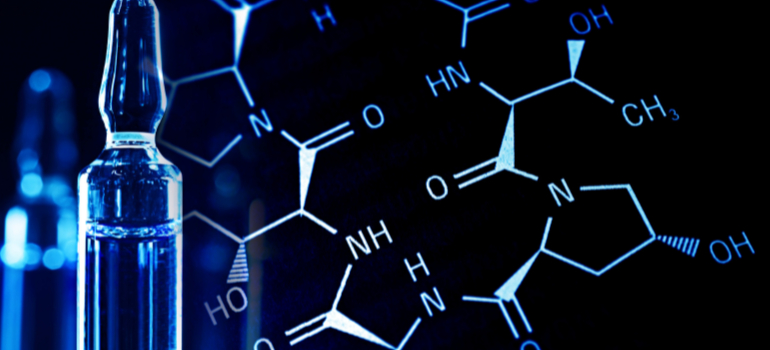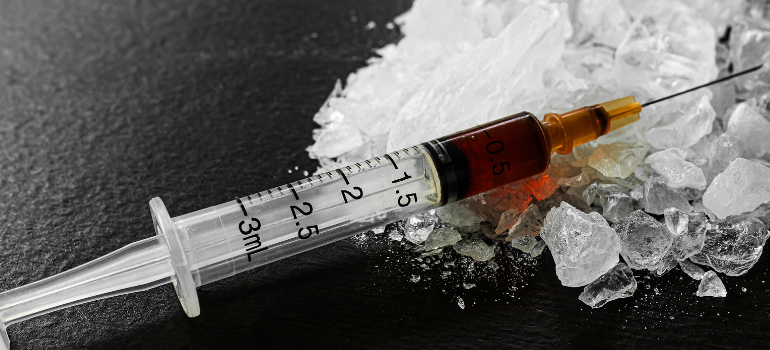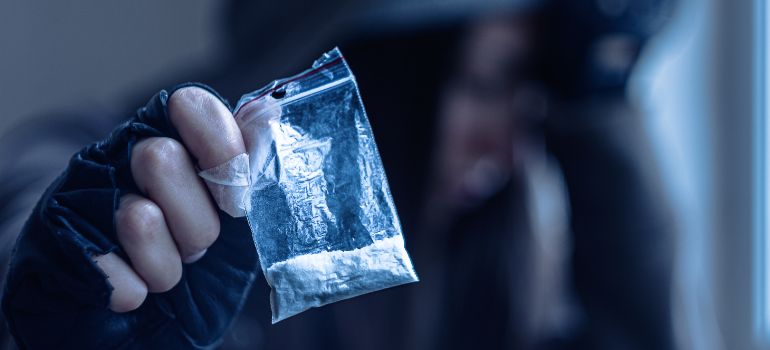Exploring the Dangers and Realities of Bath Salts
In recent years, a disturbing trend has emerged in the world of synthetic drugs: the rise of bath salts. While the name might evoke images of soothing baths and relaxation, the reality is far more sinister. These potent, mind-altering substances have been linked to a wave of alarming incidents, from violent outbursts to severe health crises. As we look into the dangers and realities of bath salts, we will uncover the dark truth behind this deceptively innocuous-sounding drug, exploring its impact on individuals and society. Prepare to be shocked and informed as we navigate the perilous world of bath salts.
Jump to Section
What Are Bath Salts?
Bath salts refer to synthetic drugs marketed under the guise of bath products for recreational use. Despite their name, these substances are not actual bath salts but mimic their texture and appearance. This deceptive labeling, often accompanied by the disclaimer “not for human consumption,” is a tactic to skirt legal regulations.
Bath salts serve as legal substitutes for drugs like cocaine, methamphetamine, and MDMA. Their psychoactive ingredients are synthetic derivatives of cathinone, a stimulant naturally found in the khat plant, native to East Africa and Saudi Arabia. Similar to the substances they mimic, bath salts carry significant risks to both physical and mental health and can lead to addiction.
Since 2010, there has been an increase in overdoses related to bath salts in the United States. This rise in overdoses highlights the importance of seeking help from an addiction treatment center in Pennsylvania for those struggling with dependency.

Chemical Composition and Psychoactive Properties
Bath salts contain synthetic cathinones, which are stimulants similar to amphetamines. The most common types of cathinones, now illegal in most countries, include:
- 4-methylmethcathinone (mephedrone)
- 3,4-methylenedioxymethcathinone (methylone)
- 3,4-methylenedioxypyrovalerone (MDPV)
MDPV is the most prevalent synthetic cathinone found in bath salts. Due to the high toxicity of these compounds, all three have been banned under US law, yet similar substances continue to emerge on the market.
Synthetic cathinones in bath salts interact with plasma membrane transporters for dopamine, norepinephrine, and serotonin, specifically targeting monoamine transporters. Drugs targeting these transporters can be either substrates or blockers. Synthetic cathinones, like amphetamines, are substrates, which stimulate the release of neurotransmitters by reversing their usual transport direction in the brain. In contrast, cocaine functions as a blocker. Some studies also suggest that mephedrone and methylone might act as transport blockers.

How Bath Salts Are Used
People consume bath salts in various ways. The most common method is snorting the powder, leading to rapid effects. Others ingest bath salts in capsules, which delays the onset of effects. Some users inject dissolved bath salts, resulting in a stronger and quicker high, while smoking the vapors produces immediate effects.
Each method has specific risks:
- Snorting can damage nasal passages and cause chronic nosebleeds.
- Injecting increases the risk of infections, collapsed veins, and bloodborne diseases.
- Smoking irritates the lungs and can cause respiratory distress. Ingesting leads to extreme nausea and severe stomach cramps.
The intense high often leads to erratic and violent behavior, endangering both the user and others. Awareness of these risks is crucial for preventing the adverse effects associated with bath salts. Understanding the dangers and realities of bath salts is essential for recognizing the severe consequences of their use.
For those struggling with addiction, seeking help from facilities like the rehab in Reading PA, can provide the necessary support and treatment to overcome dependency and mitigate the serious health risks associated with bath salts. Understanding these dangers is crucial for effective prevention and recovery.
What Are the Reasons for the Popularity of Bath Salts?
In low doses, these synthetic drugs enhance both mood and alertness. Higher doses can be lethal, and they are often used at the same time as both legal and illegal drugs. People turn to bath salts because they can be purchased somewhat legally, and their recreational use makes interactions with other people more pleasant. Because they are stimulant drugs, people may start using bath salts to have better performance both at work and at school. They often pair bath salts with depressants like alcohol to counteract the effects of the latter. For example, some people may snort or inject bath salts after a heavy night of drinking because they are afraid of passing out from drinking excessively.

Exploring the Dangers and Realities of Bath Salts: The Dark Side of Bath Salts
Higher doses of psychoactive bath salts can lead to neurological and cardiovascular complications. Said complications may endanger your life. In addition to that, they can cause hallucinations, delusions, and even psychosis and suicidal thoughts. Among the neurological complications, they can cause seizures, which can be life-threatening. The possible dangers that synthetic cathinones pose have to do with the fact that they are stimulants and can increase blood pressure and heart rate.
Misconceptions and Confusion
There are many misconceptions about the recreational use of bath salts. These misconceptions can be dangerous because they can act as encouragement for consumers. This leads to people perceiving this drug as safe or pure when, in reality, bath salts can be lethal.
Misleading Name
The term “bath salts” leads many to believe these substances are harmless products intended for bathing. In reality, the name is a deceptive marketing tactic to evade regulation and legal restrictions.
Legal Misconceptions
Some people assume that because bath salts are sold openly, they must be legal and safe. However, many synthetic cathinones are illegal, and even those not yet banned can be extremely dangerous. The perceived legality of bath salts can lead some users to believe they are, in fact, relatively safe to use, when this is not the case.
Misconceptions About Their Origins
Users might think bath salts are natural products similar to the khat plant. While synthetic cathinones are chemically related to cathinone found in khat, they are entirely synthetic and often much more potent and hazardous.
Perceived Purity
People might assume a consistent composition and potency, but the exact ingredients and their concentrations can vary greatly between batches, leading to unpredictable and potentially dangerous effects. Users may believe they are getting a pure product, but bath salts are often adulterated with other unknown substances.
Misconceptions About Their Effects
Given their availability and marketing, some users may expect effects similar to mild stimulants like caffeine or nicotine. In reality, bath salts can cause severe, life-threatening reactions. Many users might not anticipate the severe psychiatric effects, such as intense paranoia, hallucinations, and violent behavior.

Dangerous Effects on the Body and Mind
Toxicology reports from recent years indicate that the compounds in bath salts are indeed dangerous. When taking them, you are exposing yourself to a potential overdose, death, or permanent damage from neurological and cardiovascular complications. Because of both the popularity and unpredictability of synthetic cathinones, they are among the deadliest drugs in Pennsylvania.
Physical Health Risks
Short-term physical risks of synthetic cathinone use can lead to the following symptoms:
- Nausea and vomiting
- Abdominal pain
- Increased heart rate or tachycardia
- High blood pressure
- Chest pain
- A heart attack
- Seizures
- Skin lesions
- Dehydration
- Kidney damage
- Involuntary muscle movement including tremors
- Muscle breakdown, which can lead to kidney damage
- Toxic reactions like hyperthermia (dangerously high body temperature), which can be fatal without immediate medical intervention
Please note that a lot of these can lead to death and chronic, severe health issues and you would only need to try bath salts once. However, there are also long-term physical effects from synthetic cathinone use. These include chronic insomnia, weight loss, and increased chances of overdose.

Mental and Emotional Health Risks
Consuming bath salts poses significant mental health risks. Users may experience aggression and agitation, potentially leading to legal issues. The drug can induce hallucinations, delusions, and paranoia, which can worsen pre-existing conditions like borderline personality disorder (BPD) or bipolar disorder. Even those without prior mental health diagnoses can suffer psychotic episodes from bath salt use.
Additionally, bath salts can cause severe anxiety, mood swings, depression, and emotional numbness. The drug may increase impulsive behavior, driving some individuals to self-harm. Users may also face disorientation, confusion, impaired judgment, and memory loss. Prolonged use can contribute to the development or exacerbation of chronic mental health conditions such as schizophrenia or bipolar disorder. Persistent psychotic symptoms, including delusions and hallucinations, may continue even after discontinuing use. The high potential for addiction can quickly lead to a cycle of dependence and worsening mental health, culminating in a substance use disorder.
If you or someone you know is experiencing symptoms related to bath salt use seek help immediately. Facilities like drug rehab center in Scranton PA, offer comprehensive treatment programs designed to assist individuals in overcoming addiction and reclaiming their lives. Reaching out for help is a vital step towards recovery and long-term well-being.
Legal and Social Consequences
The use of bath salts not only poses severe health risks but also carries significant legal and social consequences. These synthetic drugs are often classified under controlled substance acts, making their possession, distribution, and use illegal in many jurisdictions. Individuals caught with bath salts can face criminal charges, fines, probation, or even imprisonment. A criminal record from drug-related offenses can affect future employment, housing, and educational opportunities, creating long-term hurdles.
The dangers and realities of bath salts extend beyond health, leading to severe social consequences. Users often face stigma and isolation, which can exacerbate mental health issues and hinder recovery. Relationships with family and friends may become strained, leading to a diminished support network. The erratic behavior and cognitive impairments caused by bath salts can result in job loss and difficulty securing new employment. Financial hardship often follows, as the cost of maintaining a drug habit, coupled with legal fees and potential job loss, can lead to significant financial difficulties.

Treatment and Support for Bath Salts Addiction
Seeking treatment for bath salts addiction involves a combination of various approaches:
- MAT Detox: Medically Assisted Treatment (MAT) uses FDA-approved drugs to manage withdrawal symptoms from synthetic cathinones found in bath salts. This is typically done in a residential treatment center in Pennsylvania. An initial evaluation will determine if MAT is suitable for you. Due to its taxing effects on the body and mind, MAT requires strong motivation to quit substances, and not everyone qualifies.
- Drug Rehab Programs: These programs may include dual diagnosis treatment if needed, psychotherapy (individual and group therapy), and holistic treatments such as yoga and art therapy. At Little Creek, scientifically proven psychotherapy options are available, including Cognitive Behavioral Therapy (CBT) and Dialectical Behavior Therapy (DBT). CBT helps identify and change negative patterns of thinking and behavior, while DBT combines elements of CBT and mindfulness to aid emotional regulation and reduce impulsivity.
- Outpatient Detox Rehab: For those who need it, outpatient detox rehab in PA allows individuals to continue their recovery while living at home.
At Little Creek Recovery, the treatment process begins with an initial evaluation to determine the appropriate treatments and what your healthcare will cover. The evaluation also checks for dual diagnosis, as many people use bath salts to cope with undiagnosed chronic mental health conditions. If diagnosed with depression, anxiety, a mood disorder, or a personality disorder, you will receive treatment and education about managing these conditions.
Holistic treatments, including meditation and art therapy, provide strategies and coping mechanisms for everyday stressors. These treatments help address subconscious information that may arise during therapy. From the start of rehab, you will prepare for your return to daily life. Federal law mandates that all healthcare options cover at least part of your drug rehab, and Aetna rehab coverage can assist in quitting bath salts for good.
The Urgent Need for Awareness and Action
As the harrowing dangers and realities of bath salts come to light, it becomes increasingly clear that awareness and proactive measures are essential in combating this growing epidemic. The deceptive nature of these substances, coupled with their devastating effects on both individuals and communities, demands urgent attention from policymakers, healthcare professionals, and the public alike. Education and awareness campaigns can play a pivotal role in preventing new users from falling into the trap of bath salts, while robust support systems are needed to aid those already affected. Only through a concerted effort can we hope to mitigate the impact of this dangerous drug and safeguard the well-being of our society.